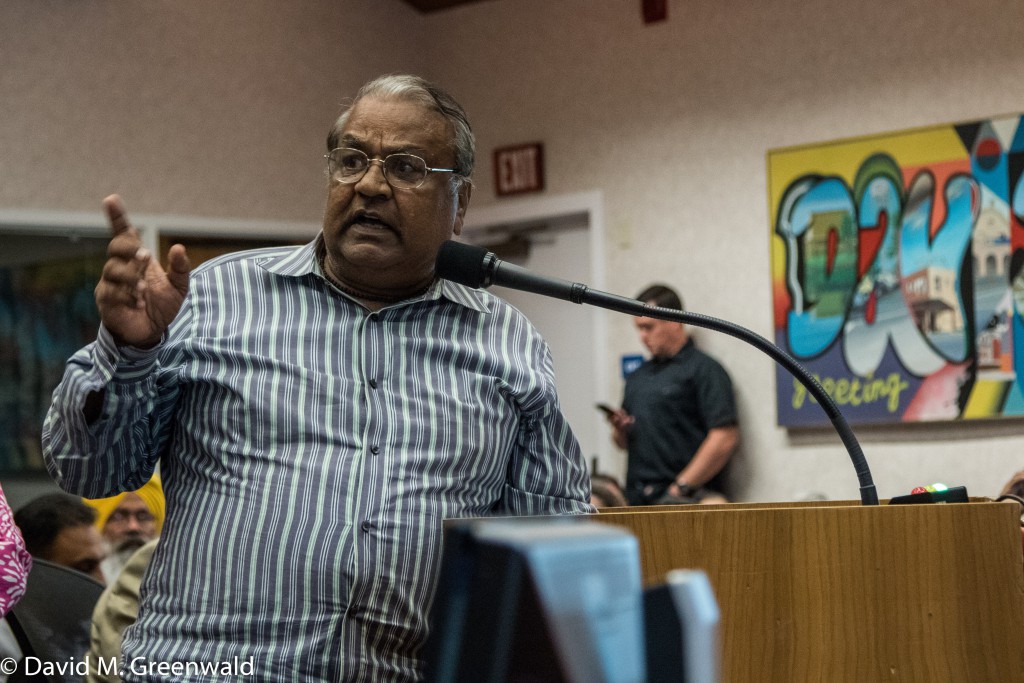
In February, the Davis City Council on consent voted 5-0 to accept a Gandhi statue, donated from the Indian government for a placement in Central Park. So why, more than six months later, did Mayor Robb Davis and Mayor Pro Tem Brett Lee bring back the item for reconsideration?
They explained that groups of people – many of whom were Sikh and saw Gandhi not as a hero for peace but as a flawed individual who subjugated their population, seeing him not “as something we should aspire to” – had pressed for reconsideration and, therefore, the mayor and mayor pro tem saw it as a duty to hear out that group and pause the process.
After hours of at times contentious public comment, the council rejected reconsideration on a 3-2 vote, with the mayor and mayor pro tem dissenting.
The staff report from February indicated there is no cost incurred by the city for this donation. “The acquisition, installation, and ongoing maintenance costs for the proposed bronze sculpture shall be incurred by the donor, according to City policy.”
It was longtime Davis resident Sham Goyal, a retired faculty member from UC Davis, who arranged the donation and brought it from India. It was noted during the public comment period that many of those opposing the statue in the park are non-Davis residents.
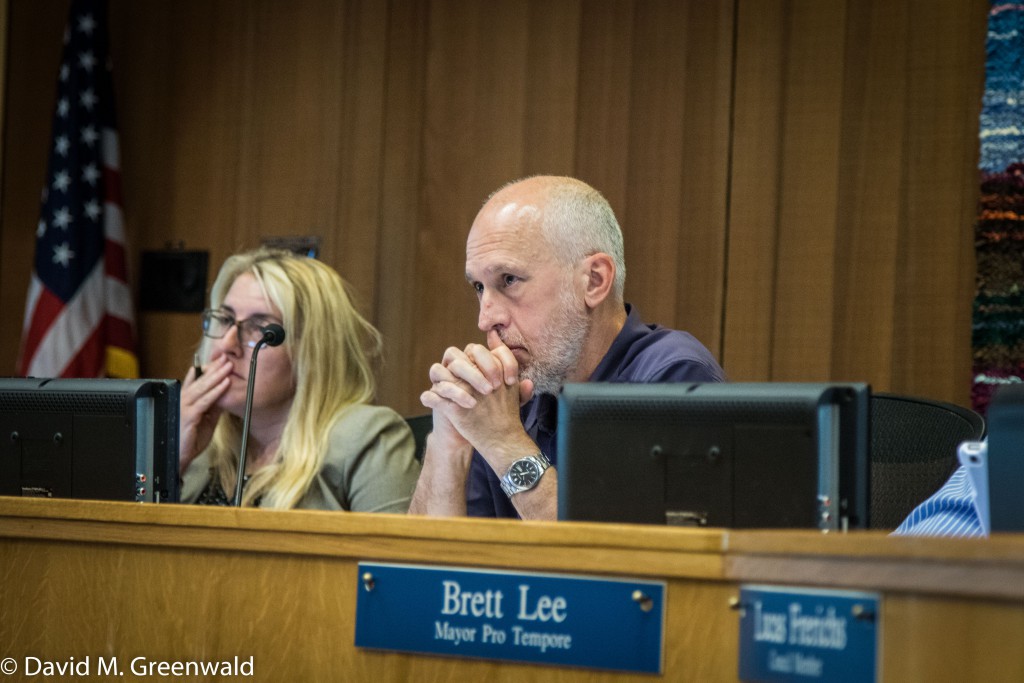
Mr. Goyal told the council that “erecting a statue of Gandhi is extremely relevant in this town in order to portray the fundamental character of this town.” He indicated that “today I am standing in front you with my heart bleeding and head down in shame. I am hurting very badly due to the actions of the mayor and mayor pro-tem.”
He continued, “The city leadership, in a total disregard to hundreds of people’s feelings, have the brought the Gandhi statue item back to the city council agenda today. What for? All to please the feeling of only one or just a few Davis residents. They probably do not realize that in doing so they have set up a very dangerous precedent.”
Anita Dhesi, born in Davis and a lifelong resident, said, “I, too, have been a proud member of the Gandhi Statue Committee since we began this effort more than a year ago. I, too, am a member of the Sikh religion. And I, too, share the same unflagging commitment to the values of peace and non-violence that this statue represents, indeed, the very same values that Davis represents! As my good friend Sham Goyal points out, many cities that have a Gandhi statue are major metropolises, from New York to Washington, DC, and San Francisco. But we know that though Davis is small, we have an outsize commitment to peace and non-violence. This statue represents and celebrates our community’s longstanding commitment to peace and non-violence, and Davis’ warm embrace of diverse people.”

School Board President Madhavi Sunder argued that “there seems to be little reason” to reconsider the item. She noted that the public process was “thorough, complete and transparent.”
“The issue of receiving the gift of this statue went before two public commissions and the entire city council. The issue was on the public agenda of the Davis Arts Commission no less than nine times,” she said. “Reopening this issue disregards the many citizens and public staff members who have worked hard in reliance on the council’s decision. Sham Goyal on the council’s approval of the project flew to India and returned with a 1000-pound bronze statue, which is sitting now in a Davis warehouse. Asking for additional process now after one side has complied with the regular process makes a mockery of the rule of law.
“As a citizen of Davis, I could not be more proud to have this most powerful symbol of peace and non-violence stand in the Central Park of my community.,” Ms. Sunder continued. “You’ve heard the accusation that Gandhi was a racist. But it was none other than Nelson Mandela himself who unveiled a similar statue in South Africa in 1993, declaring, ‘The Mahatma is an integral part of our history.’ Mandela explained that ‘Gandhi is most revered for his commitment to non-violence and the Congress Movement was strongly influenced by this Gandhian philosophy, it was a philosophy that achieved the mobilisation of millions of South Africans during the 1952 defiance campaign, which established the ANC as a mass-based organization.’”
Ms. Sunder’s 8th grade daughter, Anoushka Chander, was particularly eloquent, quoting Gandhi and saying, “Where there is love, there is life.” She noted his role in the Indian independence movement, noting that worldwide “he is known as a peace symbol and advocate for non-violence.” She called him “a man who brought India to freedom and lit a fire for independence around the world.”
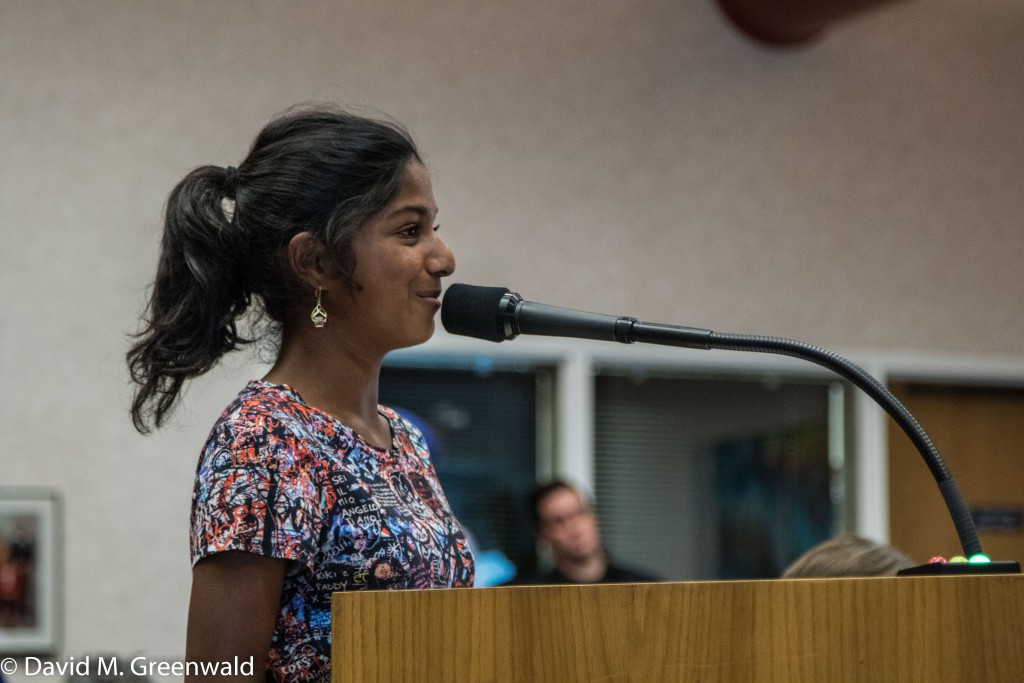
Akash, a sophomore at Davis High, added that he was a man who “liberated his country simply through the power of peaceful protest.” He said, “He did not only inspire Indians, but all those who fight against tyranny and oppression through non-violence. He represents not just an independence movement but a right to speech and protest, a right we as Americans cherish.”
However, the push back was strong from those in the Sikh community around the region. One person noted that he was proud of the children speaking, but he had a different view of the man. He said that, for many people in India today, they have no access to education or medicine. He argued that Gandhi did nothing for those people in the country.
Others pointed to research showing that Gandhi had a series of sexual indiscretions throughout his lifetime and may have had sexual relations with minors and relatives.
Amar Shergill said, “My need is I want Davis to remain a special place. A place that respects social justice. A place where I can bring my children to Central Park and not have a repugnant image hovering over us.”
He said that we have heard from many professionals supporting the statue “and none of them have said that it is untrue what we have said regarding Gandhi – that he was a bigot, that he was a sexual predator, that he was involved in casteism, none of them has said that was untrue.”
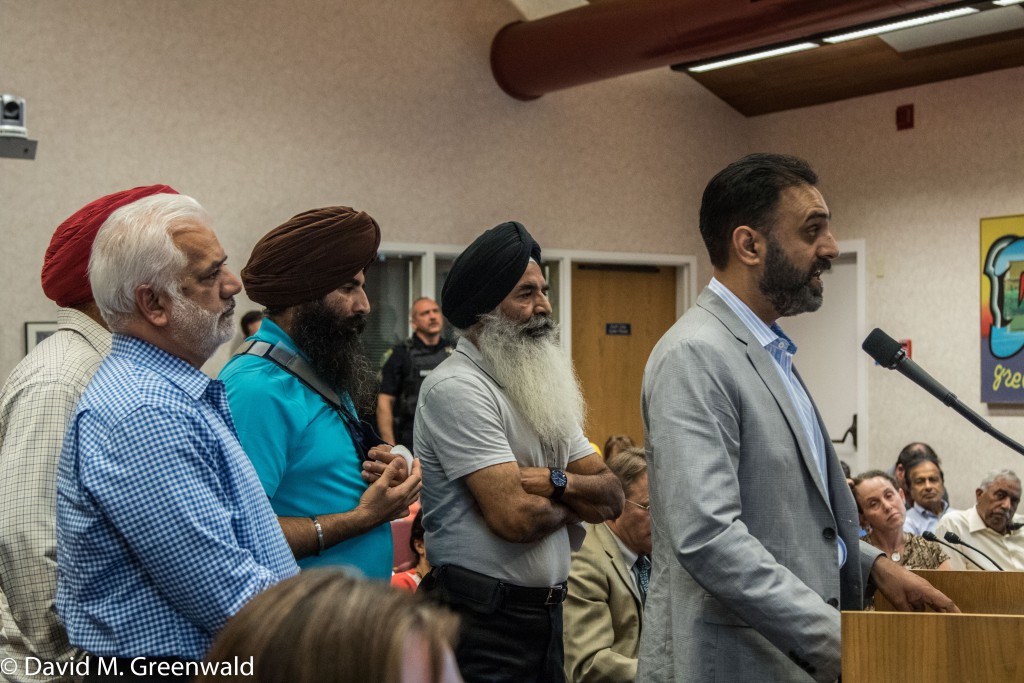
Mr. Shergill argued that, if he were proposing the statue, “I would make sure at the very least that we would make those accusations go away.”
However, Sean Raycraft countered that he did not previously know many of the controversial things that Gandhi had done, and “these larger than life historical figures are often mischaracterized by history in the narrative.” “Historical figures need to be humanized,” he said. He asked that there be “some consideration as to humanizing the man, and not mythologizing the man.”
With Brett Lee and Robb Davis putting forward this matter for reconsideration, it came down to their colleagues’ votes. Rochelle Swanson noted that there doesn’t have to be one statue, “that is not the Davis way.” She noted that it is important that we honor the international day of Peace and non-violence. She said that no one is perfect but felt comfortable with the procedure that the council had followed.
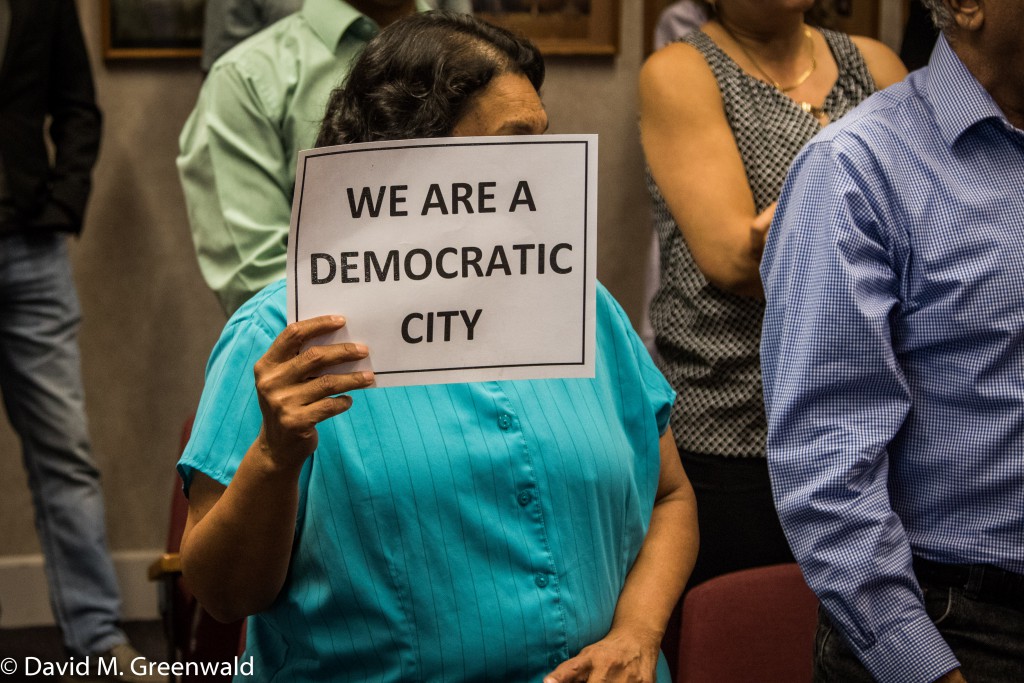
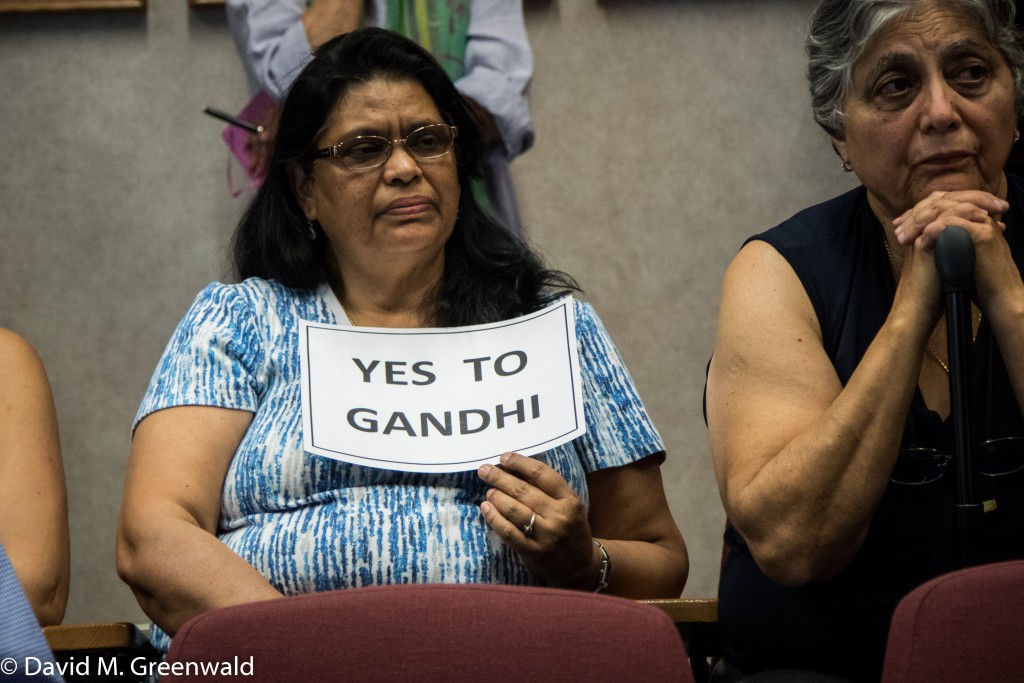
Councilmember Lucas Frerichs said the process, “frankly, has been transparent and thorough.” He said, “I supported it then, I support it now.” He noted that, for the opposition, “the process will never be enough.” He concluded, “I do not support reconsideration at this time.”
Councilmember Will Arnold added, “Gandhi is history’s greatest teacher of humanity’s most important lesson, that peace is its own reward.”
Robb Davis acknowledged that this process would never lead to agreement between the two sides, but it leads to a time and space to listen to each other’s concerns. He recalled his father’s opposition to Martin Luther King, Jr., and finally, after years of turmoil, hearing his father out on why he despised MLK – which had less to do with the man and more to do with the change in the country.
The council then voted 3-2 to oppose reconsideration.
—David M. Greenwald reporting






I simply don’t get why Robb and Brett voted to re-open this discussion? It seems like a no brainer to me. Gandhi in the park where people have been holding vigils for peace every Saturday for years. People object to Gandhi, no kidding. He didn’t die from old age, but he did change the world through non-vilolence, ending the era of European colonial dominance. People object to Martin Luther King Jr. and Cesar Chavez because they too were imperfect. We are all imperfect so, by that standard, nobody should ever be honored or looked up to in reverence. Its absurd.
There is a very old common law concept that you can’t defame the dead. That was before the Internet.
Now, I’ll add another more contemporary and relevant truism: We are no longer allowed to have heroes.
John Sutter was a recent past example here in Davis. While it was an act of circumstance more than design, John Sutter put California on the map of world history and his name was given to a county, innumerable streets, schools, and a health care group. When an obscure 2-block street was tagged with that name in Davis, another patented “Davis Crisis” was born. Huge quantities amounts of local time and contentious debate was generated, with the inevitable result of nothing changed. Other, more pressing, public issues with many greater numbers of flaws were suspended or ignored.
Now, it’s Gandhi. Gandhi was not perfect, that’s supposed to be a revelation. Gandhi MAY have been this or that and evidence be dammed. Therefore Gandhi should not have a statute in Davis because he shall be judged by a standard of perfection.
Abide by this measure and we have to tear down all human representations of greatness in public places. Starting with Davis, (of course) we can officially declare, America is no longer allowed to have heroes because our heroes have to be perfect and withstand any scrutiny.
No such person has ever lived, or will.
Supposing we took all those hours of Council debate and public comment and devoted it to new ideas for resolving our budget deficit. Maybe we should erect a public monument memorializing wasted public policy deliberation. There’s a statute that would be very well received. I’d salute it every time I passed by.
Phil wrote:
> I’ll add another more contemporary and relevant truism:
> We are no longer allowed to have heroes.
For the most part people “right of center” are still OK having heroes (I have never heard a Sutter Club member asking to change the name of the club after finding out that John Sutter built a home for his mistress “across the river” in what is now El Macero).
In recent years I have noticed that many “left of center” people are working to get anything negative they can find out about people they feel were not “progressive enough” (even in a time when almost no one was considered “progressive”) yet they ignore the bad stuff that their “heroes” Lenin and Stalin did “because they were working toward a noble goal”…
P.S. Let’s hope the “progressives” in town don’t find out that Jerome Davis didn’t offer health care or pay overtime to the guys running his ferry across the Sacramento River in the 1850’s and try and change the name of our city…
If you drive west on the 80 you will arrive at a small city where everything is named after Harvey Milk including a street, plaza, center of the arts, civil rights academy, library, etc. Seems a little excessive but perhaps it just reflects a lack of imagination in that particular village. I understand the Navy just named a ship after Mr. Milk though perhaps as a bit of fun it’s the ship that carries the lubricants for the fleet.
What about Jesus — HMMMMMMM?!?!!
Might work, but the chambers would be empty (standing room only last night).
Of course, John Sutter’s peers “indicate he raped Native American women as young as 12” but sure, we should keep naming things after him.
I don’t have a problem with a free Gandhi statue. I’m just thankful we weren’t offered a Mao statue.
Now that the council decided to have the statue erected even though Gandhi had his indiscretions we should keep that in mind when a few activists cry about our local street and building names.
What’s head scratching is that two council members actually changed their vote because of a few complainers. That’s why we can never get anything done in this town.
http://naturemappingfoundation.org/natmap/photos/birds/rock_dove_4064np.jpg
Beaujolais Rockdove III thanks you.
Is there a photo of this statue somewhere? Is this life size?
I hear it’s the same size as the Statue of Liberty. It’s on a boat right now and will be here in a few weeks.
Are they floating it up Putah Creek??
They’re using the same waterways that our Davis plastic bags use to make it all the way to the Pacific Ocean. (At least that’s what the plastic bag banners tried to tell us)
The city told the shipping company to just follow all of the floating Nugget plastic bags up the river and it will take them straight to Davis.
In other news: I read in the Enterprise that the statue is bronze, 6′ tall and weighs 950 lbs.
Thanks BP. I checked the DE. It’s 6’4″ so bigger than life size. They went with the “Old Gandhi” while I would have voted for the “Young Gandhi with spinning wheel”. Being bronze when the birds crap on it the copper will dissolve and leach into the surrounding soil where it will flow into the pacific ocean on poison the otters and sea lions.
Rochelle said there could be other statues, so maybe the next chamber debate will be whether to get a Fat Elvis statue or the young, thin Elvis.
Young Elvis, another no brainer, he was beautiful.
quielo wrote:
> Is there a photo of this statue somewhere? Is this life size?
A “life size” statue of Gandhi would not be very big since he was just a couple inches taller than Prince (and an average junior high girl)…
“But he said that for many people in India today they have no access to education or medicine. He argued that Gandhi did nothing for those people in the country.”
Using this rationale, we could never memorialize anyone or any set of actions. We would certainly not be able to have statues of JFK or MLK because of their less than pristine personal activities. With this as our standard,we could not memorialize Lincoln because he failed to prevent Jim Crow even while holding the union together.
I believe that sometimes it is important to weigh the entirety of the contribution of an individual in deciding whether or not their actions are worthy of memorialization. Using this standard instead of highlighting individual flaws, which we all have, there is no doubt in my mind that the contributions of Gandhi to non violent protest , peaceful advocacy for change and the rights of the people to act in their own best interests are beyond a doubt worthy of recognition.
Those opposed had a set of bullet points they kept repeating, and it wasn’t pointing out flaws as seems to be the thread here, it was outright condemnation. He slept naked with relatives, implying incest; he was a friend of Hitler, implying he may be a Nazi, etc. Everyone, do not get lost on the tangent they were pointing out his flaws — he was being outright condemned as an evil man.
Uh, Tia… Jim Crow laws etc. happened after the Civil War… Mr Lincoln was more than 6 feet under by then.. please get your facts straight… wasn’t much Lincoln could do once Booth shot him… re-read his 2nd inaugural address (if you’ve ever read it)…
https://en.wikipedia.org/wiki/Abraham_Lincoln%27s_second_inaugural_address
Yeah some people reject the “God” thing…
Lincoln lived only 4-5 weeks after he delivered that address… it is galling, at the very least to blame Lincoln for the ‘Jim Crow’ stuff… and also damn ignorant…
hpierce
That did not escape my attention, and in fact was my point. Just as Lincoln could not be held responsible for situations that occurred after his death, Gandhi cannot be held responsible for inequities and inadequacies of Indian society today as the comment I quoted implied.
oh Davis… huge on emotion and short on any comprehension of history.
Indian Summer by Alex Von Tunzelmann. Gandhi advised the British to give up the fight against Hitler and Mussolini, and the Jews in Germany to offer passive resistance to the Nazi regime:
“Gandhi’s position on nonviolence was absolute. Aggression could never be returned. He did not believe that women should resist rape, but preferred that they should ‘defeat’ their assailants by remaining passive and silent. Correspondingly, he did not believe that the victims of war should resist attackers by physical force, but rather ought to offer satyagraha — that is, noncompliance with the invaders. ‘If there ever could be a justifiable war in the name of and for humanity, war against Germany to prevent the wanton persecution of a whole race would be completely justified,’ he wrote. ‘But I do not believe in any war.’
“He advised the British to give up the fight against Hitler and Mussolini: ‘Let them take possession of your beautiful island … allow yourself, man, woman and child, to be slaughtered, but you will refuse to owe allegiance to them.’ Furthermore, in one of his most controversial arguments, Gandhi advised the Jews in Germany to offer passive resistance to the Nazi regime — and to give up their own lives as sacrifices. He told the Jews to pray for Adolf Hitler. ‘If even one Jew acted thus,’ he wrote, ‘he would salve his self respect and leave an example which, if it became infectious, would save the whole of Jewry and leave a rich heritage to mankind besides.’
Gandhi leading the 1930 Salt March, a notable example of Satyagraha.
“Gandhi compounded this error of judgment by offering praise to Hitler. ‘I do not consider Herr Hitler to be as bad as he is depicted,’ he wrote in May 1940. ‘He is showing an ability that is amazing and he seems to be gaining his victories without much bloodshed. ‘ Apparently, he saw some parallel between his own efforts to return India to the Indians and Hitler’s invasion of French territory to reclaim that lost to Germany under the terms of the Treaty of Versailles at the end of the First World War. He regretted that Hitler had employed war rather than nonviolence to achieve his aims, but nonetheless averred that the Germans of the future ‘will honour Herr Hitler as a genius, a brave man, a matchless organizer and much more.’
“The American journalist Louis Fischer brought up this subject with Gandhi in 1946. By that time, the concentration camps had been discovered, and the true, awful extent of the Holocaust revealed. It might have been expected that the benefit of hindsight would have tempered the old man’s views. It had not. ‘Hitler killed five million Jews,’ Gandhi told Fischer, ‘It is the greatest crime of our time. But the Jews should have offered themselves to the butcher’s knife. They should have thrown themselves into the sea from cliffs. . . . . As it is they succumbed anyway in their millions.’ “
I think, in the spirit of inclusiveness, that a summary of Gunrock’s info (apparently taken from real sources) be included in a memorial plaque to accompany the statue, once installed, close to any other plaque of “praise” or veneration.
Alternately, we could add a statue of Mother Teresa of Calcutta to reaffirm the non-violence, human dignity theme…
Maybe on the other side of the park we could have a statue of Sargent Rock. Being a comic book character there is no chance of embarrassing revaluations about his personal life and he certainly had a different approach to world problems than did Gandhi.
Why the outrage?
It’s not like we’re putting up a statue of George Washington or Paul Revere.
The horror! George may be OK. We need to find out if his teeth were sustainably harvested.
Yes Woody, we don’t know either if Paul was mean to his horse.
We do know that Paul was involved in the toxic metals fabrication business and did not provide proper PPE to his workers or family.
Because to people in the Sikh community or at least segments, this is like putting up a statue of Sherman in Georgia. I don’t happen to agree with that, but that’s where this is coming from. I
Los Angeles has Blackjack Pershing. Arcata has William McKinley. Coloma has John Marshall. D.C., Carmel and Hillsborough have Junipero Serra. UC Davis has eggheads. But Gandhi in Davis is a problem???
We have MLK at the Law School, Ceasar Chavez at an elementary school and now Gandhi in the park. All we need to do is live up to the standards we set for ourselves.
How about a bust of Katehi at the landfill?
LOL, and covered in old ripped plastic Nugget bags.
As I am applying for the position she formerly held it’s not appropriate I comment further. Thank you for your understanding.
Get in line. In order to get the job I’ve been holding nightly vigils with the student activists and promising them more safe spaces, more professors of color, more gender neutral restrooms while condemning both cisprivilege and the oppression of the Patwin Tribe. You don’t have a chance.
Too Late BP, I’ve already told them you view plastic bags as a joke. They were shocked. My platform is to increase the number of Chinese and Thai restaurants and I stand behind my slogan, “Boba on Demand”.
I am also renaming “College Park” to “Greek Street” and using eminent domain to turn the houses there into frats and sororities.
And your racist remark disqualifies you too.
To be honest Quielo I don’t think either of us have a chance because thay’re most likely looking for a ‘woman of color’.
BP,
Maybe they will have their “Eva George” moment. http://www.laweekly.com/news/turning-the-tables-2148426
Quielo, there’s a fairly new series on HBO called Vice Principals.
Watch it if you can and start from the beginning. It’s only six one-half hour episodes in.
It’s hilarious and deals with some of the same subject matter as the article you referenced.
If we were to vet all historical figures for their flaws, there would be few, if any, statutes remaining anywhere. Many of the American founding fathers were slave owners, after all. Mother Teresa was, in fact, no saint. A statue of Gandhi would represent the ideals he stood for—social change through nonviolent resistance. Carried to an extreme his views were unrealistic and, in some instances, loathsome and pernicious. But, again, this is not about his heroism; it’s about the values he has come to represent.
My issue with a statute of Gandhi is that it seems those values could be represented in Davis more appropriately by any number of figures from California or U.S. history: Henry David Thoreau, William Lloyd Garrison, Rosa Parks, Martin Luther King, Jr., Cesar Chavez, John Lennon, etc. etc. Of course, no one’s offered the City a free statute of any of those folks.
Every one you listed have flaws as well… duh… they were human… Rosa Parks, by her own account, was too damn tired to move… she did not set out to be an icon. MLK was great, but no saint… ask his wife (if she was still alive, but she is not)… same for the others, except don’t know much about Thoreau, except he was opposed to military service and paying taxes…
“I have traveled a good deal in Concord; and everywhere, in shops, and offices, and fields, the inhabitants have appeared to me to be doing penance in a thousand remarkable ways.”
Henry David Thoreau, Walden
Emerson renounced non-violence when he realized that the South would never peaceably give up slavery. I guess the Transcendentalists transcended non-violence.
Well, the citizens in Concord had much to repent and do penance for… like their neighbors in Walnut Creek… one penitent acts was to have to use the tunnel on 24 to get to SF…
“Rosa Parks, by her own account, was too damn tired to move”
Totally and utterly false. A myth.
What if we had this discussion about every art installation in Davis? That’s all we would be doing at City Council meetings.
I think it’s going to be a long two years if this is any indication (as in long council meetings).
One thing I don’t understand is why was this a “vote to reconsider” rather than a “re-vote”. I gather there was some long process proposed to have everything vetted and then re-vote?
Nevermind, I read the Enterprise article.
Opposition to the statue is based on the false notion that he was a moral leader. Throughout his life, although he had many laudable achievements, he also consistently aligned himself with those that subjugate and oppress. Repeating his myth without a recognition of his repugnant acts is unworthy of the City of Davis. http://www.minoritiesofindia.org/gandhi-spreads-racial-hatred-of-africans/
wow.. this is supposed to be the land of religious freedom, right? and as a result, all religions should be free to honor whoever they wish….
also, isn’t there supposed to be separation of church and state?
therefore, why is this even being “judged” in front of the city council?
why cannot the folks who donated the statue also donate some land for it to go on?
that is done all over the city and the campus…
of course, there are many statues of lots of USA dignatories …including some presidents who were slave owners, right?
and some of those guys are even honored with a day off….
and so why is this a topic of such importance?
Ever seen the 10 commandments at a state capital? Visit Austin, TX sometime. All the statues are of Confederates, too. Wouldn’t exactly fly in Davis. What people determine is important in one place is different than another. Even in America.
Sikh and you shall find.
The front view is even worse.
Before commenting on the underlying issue, I must state how much respect I have for Mayor Davis in seeking a path that might offer something other than additional acrimony and bitterness. The City of Davis is fortunate to have him leading the way.
For those that are as shocked as I once was about the distasteful, but unfortunately true, nature of Gandhi, the following links are a good place to start your research. The first is from a South African professor regarding the unambiguous bigotry and racism displayed by Gandhi during his time opposing equality for Africans. The second is a heralded South Asian writer revealing Gandhi as a sexual predator. The third is from a leading South Asian intellectual and author investigating Gandhi’s lifelong commitment to the caste practices which deny equality to the majority of men and women.
http://thewire.in/11027/the-complicated-history-of-the-south-african-gandhi/
http://www.youthkiawaaz.com/2013/10/gandhi-used-power-position-exploit-young-women-way-react-matters-even-today/
https://revolutionaryfrontlines.wordpress.com/2014/03/01/ambedkar-gandhi-and-the-battle-against-caste/
A Gandhi statue is distasteful simply because of his repugnant behavior that contradicts the core of his legacy. However, it is especially unworthy of the City of Davis because the statue is part of a campaign by fundamentalists to promote a sanitized image abroad while they participate in the ongoing murder, rape and brutalization of minorities across India. The latter is described by the US Commission on Human Rights at the following link:
http://www.uscirf.gov/sites/default/files/USCIRF_Tier2_India.pdf
The question to the residents of Davis is not only whether you would like to have a statue of a bigot and pedophile that also made meaningful positive contributions to society; the question is also whether you would like to join in the international public relations campaign of modern-day bigots, murderers and rapists.
You have until October 1 to let your local leaders know where you stand. It is my expectation that beginning October 2, all of those that stand with the persecuted minorities of India will see Davis as an unfriendly city deserving of condemnation.